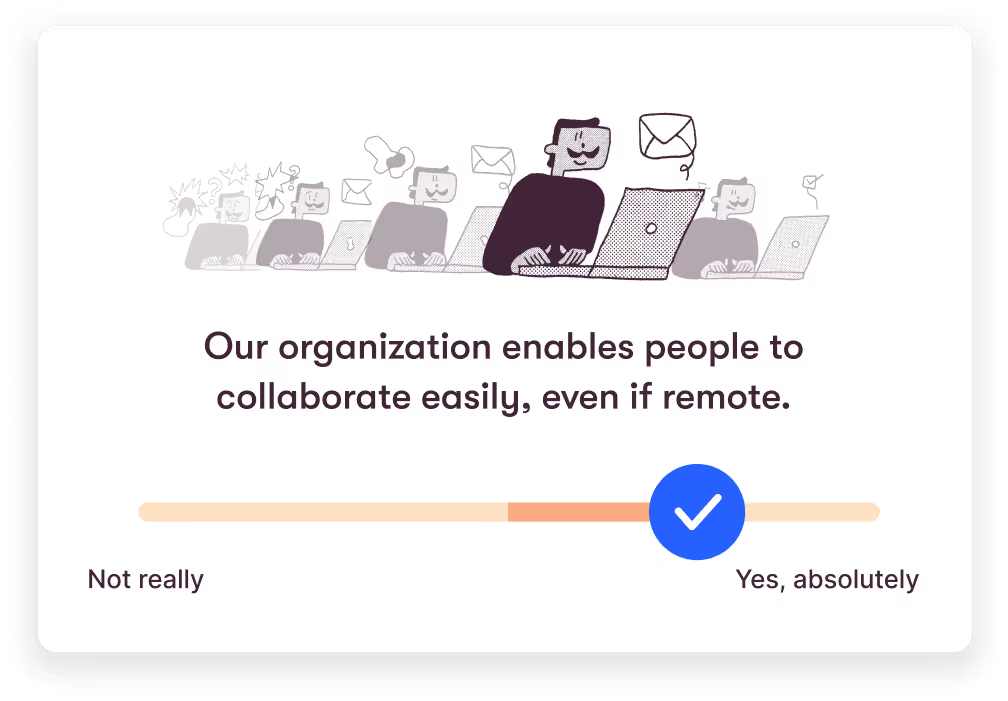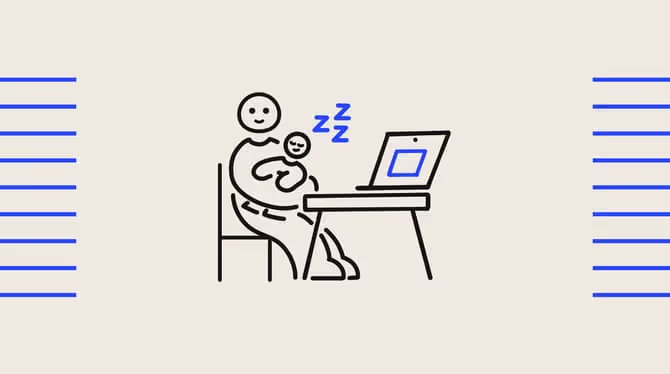30 Remote work survey questions for work from home and hybrid employees

Discover Workleap Officevibe's benchmark report on 12 key employee engagement metrics

It’s no secret that the rise of remote work has changed the way many organizations operate. Some managers adapted with ease, implementing swift and efficient new communication channels to keep the pulse on how their people feel, while others found it challenging to maintain regular contact with their newly distributed workforce.
If you’re feeling disconnected from your remote or hybrid employees, it’s important to check in often to ensure your teams feel supported. Sending your employees tailored survey questions is a great way to measure engagement levels and nip any potential issues in the bud.
Why survey your remote workers?
Most companies have realized that happy workers are productive workers and have started investing in creating a positive employee experience in the workplace.
One fundamental way to understand the employee experience is by collecting information directly from the employees themselves. Whether through one-on-one feedback sessions, team meetings, or anonymous surveys, creating a feedback culture allows managers to gather details about how employees feel about working for their company.
The rise in remote work has created specific challenges that affect employee engagement and productivity. As the trend of remote work shows no signs of slowing down, understanding how remote employees feel about their situation is vital to their continued productivity and success.
Survey questions to ask your remote, hybrid, or distributed employees
Despite offering great benefits, remote working survey questions can be tricky to formulate correctly.
A major challenge facing many remote employees is the blurring between their personal lives and work. You need to tread the fine line of asking personal questions that impact productivity, mental health and well-being, and unique difficulties without delving into specifics.
It's a good idea to keep these surveys anonymous, as this allows employees to feel more comfortable in sharing potentially personal concerns. It also prevents retribution from unhappy managers, giving employees the confidence to provide honest, genuine feedback.
Remote lifestyle questions
Some people thrive in a remote work environment, while others may need additional support. Finding out how employees have reacted and adjusted to their new situation offers valuable insight into how you can help them make the transition.
Some question examples include:
- What's your favorite part about working remotely?
- Do you have a set routine?
- Have you ever worked remotely before, and what's different about your current situation?
- Do you have many distractions during the day?
- Are you able to stop working after hours?
- What do you do for fun and to recharge from work?
- What are your main productivity barriers, and how can we help address them?

Information dissemination questions
Many decisions happen spontaneously during office discussions, and remote work can make team communication challenging. It's harder to have insightful conversations as a team, but it's also harder to keep everyone in the loop. Here are some questions to hone in on common communication issues:
- Do you feel included in major team decisions?
- Have you been blindsided by any news or information during a team meeting?
- Are our current remote working tools good enough?
- Do you often have technical difficulties with remote communication tools?
- Are our on-site meetings remote-friendly enough to encourage your participation?
Connection questions
Many people struggle to engage with text-based or video-based communications, leading to missed contexts and increased conflict between remote team members. It's vital to build strong bonds between employees, even if they don't share the same space.
- Do you feel you get into the office enough?
- Who do you go to when you have a great idea?
- Do you feel that you can approach anyone on the team with a problem you have?
- Are there enough opportunities for small talk and bonding? How do you think we could create more?
- Do you feel like you're a valuable member of the team?
Remote work planning questions
As more organizations move towards remote working and hybrid models, consulting employees is a great way to get ideas on how to implement these strategies effectively.
- How many days do you need to be in the office, based on your current workload and responsibilities?
- Are you confident that your managers are willing to promote alternative, flexible working practices?
- If you had total flexibility, what days work best for in-office work (if any)?
- Which arrangement do you prefer: hybrid, 100% remote, or 100% office?
- How can we make the transition between remote work and office work seamless for you?
Remote work productivity questions
Various aspects of working from home will affect employees differently. However, some practices will make everyone's life easier, and it's vital to implement them as early as possible to keep productivity high.
- Do you understand the company's work-from-home policies?
- Do you have clear work objectives?
- Do you feel that your manager trusts you to do your work at home?
- Are you satisfied with the quality and quantity of communication from leadership?
- Can you reach your team or your direct reports easily when you need them?
- What are your preferred communication channels when working remotely?
- Would you like to return to the office? Why or why not?
- Do you have a dedicated working space at home?
What are the struggles of remote employees?
It may be tempting to assume that managing a remote team works the same as managing people in the office. However, the shift to remote working has raised new questions and challenges for employees and managers alike.
According to Officevibe's State of Employee Experience report, almost 30% of employees have to deal with unmanageable stress levels, despite having the flexibility to work from home.
Understanding the challenges of working remotely can be tricky, especially if managers and executives remain in an office environment. That's why employee feedback is essential in providing the proper support necessary to address the specific concerns of a distributed workforce.
Maintaining a healthy work-life balance
The biggest challenge for managing remote employees is supporting a good work-life balance. Many people don't have a dedicated office space at home, leading to a blurring of lines between their personal life and job.
It can be very tempting to "just finish up this one task" before logging off. Some people also struggle to get going in the morning simply because they don't have the clear transition of going to work that gets them in the working mindset.
Loneliness
Even if your team members aren't best friends, the office fosters constant small-scale social interactions. Even simple banter between team leaders and colleagues is enough to create a feeling of camaraderie and social well-being.
Working in a remote environment eliminates almost all of these social interactions. Many remote workers find that they can spend an entire day working without speaking to another person, leading to feelings of isolation and loneliness.
Difficulties communicating and collaborating with remote team members
People communicate in a whole host of ways, including body language and other non-verbal cues. These cues give everyone context for communication and can dramatically alter the meaning of spoken words.
Text-based communication lacks the ability to accurately convey these non-verbal cues. You may think you're writing an informal, casual email, while the recipient may think you're being sarcastic or too informal. Since you can't adjust your tone on the fly, both parties lack the necessary context for effective communication in the workplace.
While video calls may alleviate some communication issues, they lack the spontaneity and real-time insights that make for a successful team.
Household distractions
Working in a dedicated office space fosters an environment without distractions where employees can focus on their work. Working remotely opens up a host of distractions, from pets to household repairs and even administrative tasks that interfere with an employee's concentration.
Many people have started going to coffee shops or renting coworking spaces to work remotely while avoiding household distractions. Unfortunately, these may not be the right solution for every team member working remotely, and it's vital to provide the right support to help hybrid or remote employees focus on their tasks.
Staying motivated
An isolated remote environment can make it incredibly difficult for people to self-motivate. Usually, an entire team will motivate itself to push harder, but the lack of constant communication can lead remote staff to feel like their contributions aren't important. While it's up to the team leader to ensure that their team stays motivated throughout a project, working remotely can make the task significantly more difficult.
Working across different time zones
Another major barrier for any distributed team is when individuals log in from different locations. Different time zones introduce a layer of administrative challenges, and getting remote teams together requires a lot more planning than simply calling an impromptu team meeting.
Having the right equipment
Not everyone that starts remote working has the resources necessary to work from home. Some people may rely on their work laptops, while others need high-speed internet access. Ensuring that everyone has what they need is a key component of helping remote teams get up and running as quickly as possible
Pulse Survey for remote workers
The goal of any short-form Pulse Survey is to get a snapshot of employee engagement in your organization. To get the most out of the survey, stick to topics that:
- Require employee feedback. Avoid asking about topics where employee opinions don't factor into the decision-making process.
- Are actionable. Only raise topics that you can change in a reasonable timeframe to show off visible results.
- Address general concerns. Pulse Surveys aren't the place to ask about individual employees' job satisfaction or personal issues and should target broader challenges facing remote employees as a whole.
Pulse Surveys give the best results when limited to a specific topic. For instance, if you want to get an idea of how employees feel about returning to the office or a hybrid model, a short Pulse Survey may look like this:
- How can leaders foster a safe working environment?
- I feel that I have the necessary resources to safely return to the office. Y/N
- I feel that leadership has taken the right measures to protect employees when we return to the workplace. Y/N
- I know the procedures and policies in place that will keep everyone in the workplace safe. Y/N
- I don't feel pressured to come to work if a family member or I feel sick. Y/N
Combining surveys with one-on-one meetings
Managing remote employees requires identifying general problems of working remotely while also helping individuals deal with specific challenges. Surveys are great at detecting general trends but may feel impersonal, leading to greater feelings of isolation and lack of communication.
Combining a wide range of surveys with one-on-ones and active listening will allow employees to feel connected and managers to set expectations. These meetings allow employees to bring up personal concerns affecting their well-being that aren't suitable as remote working survey questions.
How to optimize your survey questions for remote team members
Asking the right remote working survey questions is as important as sending out the survey in the first place. The questions you ask have a huge impact on the quality of the survey data and participation rates.
As remote working raises unique challenges, it's important to focus on these aspects. You can still use other anonymous surveys to monitor employee engagement for on-site workers or hybrid workers, but remote work surveys for fully remote employees should focus on their needs.
When optimizing your employee survey questions, remember to:
- Ask questions that identify personal concerns that may affect productivity without bringing up specific personal feelings or family situations.
- Constantly monitor employee mental health and well-being without asking generic questions where answers may change daily.
It's also important to use the survey results effectively, which means understanding that there is no one-size-fits-all solution for remote working. Short surveys will reveal trends with remote work that you can explore further in one-on-one meetings with individual employees.
Get the most from your remote employee engagement surveys with Officevibe
As employee spaces and work practices change, organizations need to adapt to keep up. Officevibe offers a host of useful employee engagement tools and resources to help you establish a feedback culture in your organization. From short Pulse Surveys to long-form questionnaires, we'll help you keep your employees motivated, happy, and productive.
Give HR and managers the clarity, confidence, and connection to lead better every day.


%20(1).avif)


.avif)
.avif)








